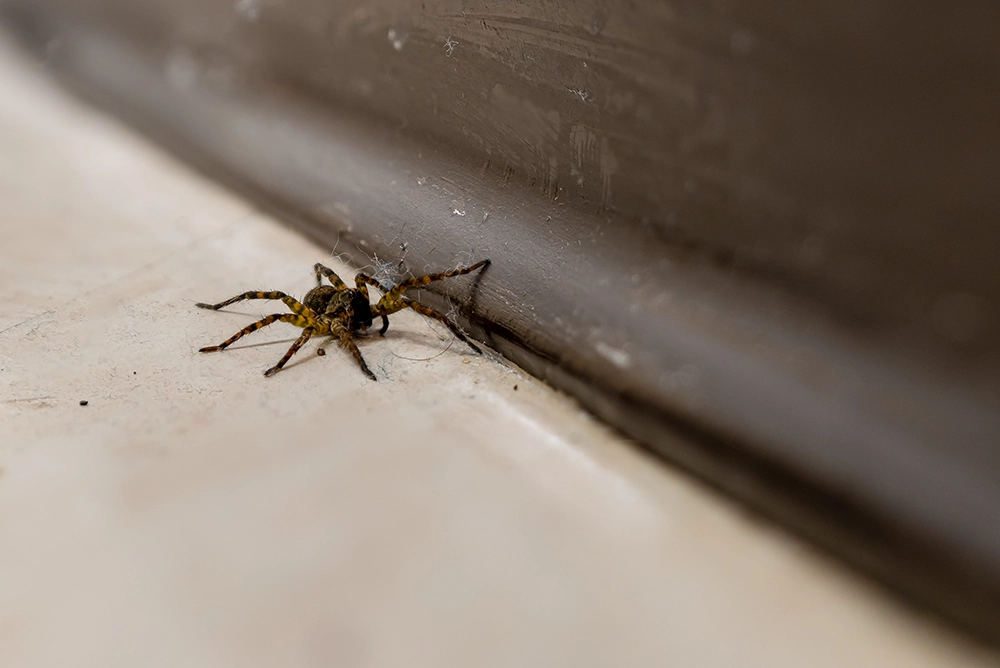
The cooler weather and shorter days of fall in Wisconsin have a big impact on spider behavior. You may notice them more often as they roam in search of food and shelter. It might look like their numbers are growing, but in truth, many don’t survive the season, leaving fewer spiders overall. That’s the real reason they seem to be everywhere right now.
The changing weather draws spiders inside, increasing your chances of seeing them. Terminix Wil-Kil Pest Control can help with professional spider treatments for year-round protection.
The Real Reasons Spiders Seem Everywhere in Fall
As fall approaches and temperatures cool, homeowners frequently spot more spiders in living spaces. While it may seem like spiders have taken over, the truth is a bit different. These are the top factors that make spiders more noticeable in the fall:
- Seeking Shelter: As temperatures drop, spiders head indoors to stay warm. Since people also spend more time inside during the fall, run-ins with these eight-legged guests become more frequent.
- More Visible Spiders: Spider numbers aren’t actually increasing, but they’re easier to notice in the fall. Their larger size, mating activity, and tendency to wander indoors all make them more visible.
- Easy Entry Points: Tiny openings around doors, windows, and siding offer spiders a way inside. Once they enter through these small cracks and gaps, they’re much easier to spot.
- Fewer Spiders Overall: Although sightings rise in the fall, the actual population decreases. Many spiders don’t survive the cold months as food becomes scarce and temperatures continue to drop.
Why Are Spiders So Easy to Notice in Fall?
Spiders don’t suddenly become more active in autumn, but their presence seems greater. A few key factors explain this:
- Autumn: Moving Indoors: When temperatures drop, many spiders head indoors for warmth and protection, making them easier to spot as they settle into new hiding places.
- Fall and Winter: Larger Spiders Stand Out: The bigger, hardier spiders tend to survive later into the colder months, which makes them more visible compared to the smaller ones that die off earlier.
- Summer: Plenty of Food: Warm weather brings an abundance of insects, allowing spiders to stay close to their webs, which are at their most productive during this time.
- Spring: Small and Hard to Spot: In spring, most spiders are young and tiny, remaining active but largely unnoticed due to their small size.
- Web Hunters: Bigger, More Noticeable Webs: As flying insects become scarce in the fall and winter, web-building spiders spin larger, more visible webs to catch what prey remains.
How Do Spiders Handle the Cold as Fall Arrives?
As temperatures fall, spiders and their insect prey face a new set of survival challenges. The seasonal shift not only affects how they live but also how they interact with their environment. Many spiders die soon after the weather turns, while others find ways to survive. The drop in food availability and harsher conditions force them to adapt quickly.
Some spiders can undergo “cold hardening,” a process that helps them tolerate lower temperatures. Even so, they seek out protection in natural shelters like leaf piles, tree bark, or bushes, though the warmth of a home is often more inviting. Spider behavior in winter varies by species. Some lay eggs in the fall, others wait for spring. While extreme cold can freeze eggs, spiderlings inside their sacs typically remain safe.
Which Spiders Are Most Common Around Homes in Fall?
Cooler weather drives spiders to look for safe spots, causing certain types to appear more frequently inside homes and yards. The following spiders are commonly seen during the fall:
- Orb-Weaver Spider
- Common House Spider
- Hobo Spider
- Giant House Spider
- Yellow Garden Spider
- Cellar Spider
How Can Homeowners Keep Spiders Away in the Fall?
Spiders often sneak inside through small gaps and openings. To stop them, seal these areas and clear potential hiding spots near your foundation. Use the following strategies to keep spiders away:
- Doors and Gaps: Check that doors fit properly and install door sweeps to seal any gaps spiders could use to enter.
- Windows and Screens: Fix or seal holes in windows and storm doors to prevent spiders from coming inside.
- Cleaning: Frequently vacuum or dust corners, ceilings, and other surfaces to remove cobwebs and discourage spiders.
- Landscaping: Keep shrubs, bushes, and other plants near your home trimmed to minimize areas where spiders can hide or build webs.
- Declutter: Remove clutter from your home and yard to eliminate potential hiding spots for spiders.
- Professional Help: Work with an experienced spider exterminator to identify infestations, apply targeted treatments, and prevent spiders from returning.
Are Spiders More Aggressive in Fall and Winter?
No, spiders don’t become more aggressive in the fall or winter. They simply move closer to sheltered areas, often inside your home. You may spot them in corners, under boxes, or near sinks and other water sources. If left undisturbed, spiders generally won’t cause harm, although sudden contact can lead to a defensive bite.
Outside, spiders slow down their activity and remain tucked away in protected areas. They may emerge on warmer winter days, but most of the time, they are far less visible than during spring and summer. Even when active outside, they tend to stay hidden and avoid people.
Terminix Wil-Kil Pest Control: Your Trusted Spider Control Specialists
Spiders are fascinating creatures, showing incredible skills and behaviors in nature. Yet, seeing them inside your home or office can be unsettling. In Wisconsin, environmental conditions can increase indoor encounters. Leave it to us! Terminix Wil-Kil Pest Control offers professional and effective spider control to manage infestations and prevent them from returning.
Contact Terminix Wil-Kil Pest Control for professional spider control that tackles infestations quickly and reliably.
Get A Free Quote
Inquiries
(800) 236-8735
